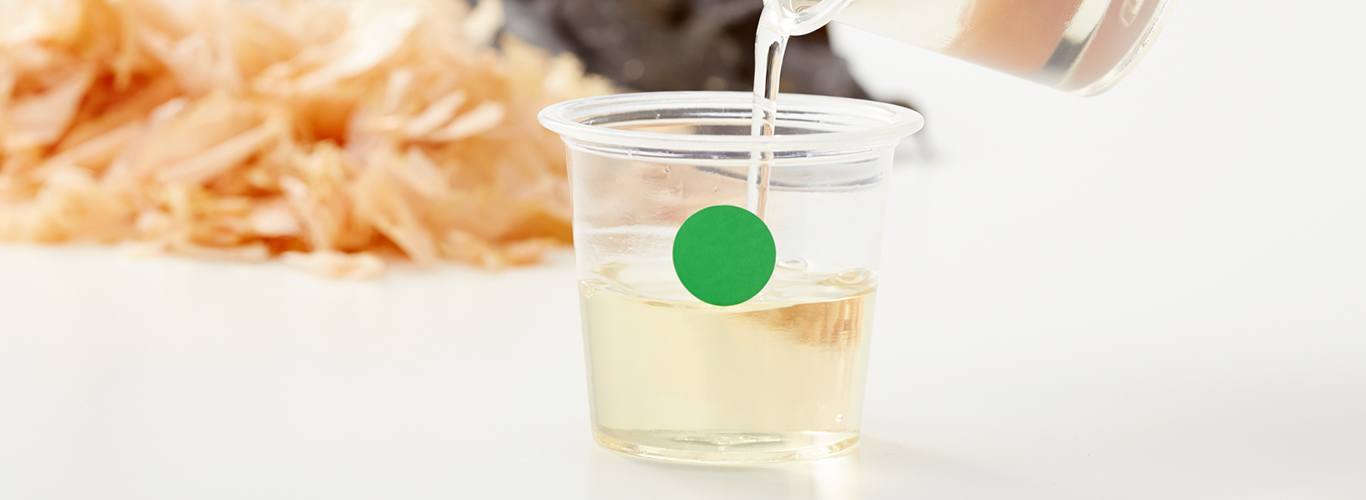Let’s try to use umami to make your recipe tastier and healthier.
In this chapter, we explain some umami effects and show you how to try in your kitchen.
The umami taste is imparted not only by the amino acid glutamate, but also by nucleotides such as inosinate, which can be found in meat and fish, and guanylate, which can be found in vegetables such as dried shiitake
mushrooms. When glutamate and the nucleotides inosinates and guanylate are combined, the umami taste of a dish is significantly magnified - about eight times more than when glutamate is alone - and there is a
synergistic effect. Many cuisines, including Japanese, Western and Chinese capitalize on this.
Let’s try to taste the effect using various types of dashi.

|
Umami Substances :
|
Glutamate
|
|
Inosinate
|
Before investigating the synergistic effect, we confirm the umami of kombu dashi and katsuo dashi
separately. Then mix two kinds of dashi and try to taste, comparing each single dashi.
How to Taste
- Sip half of the kombu dashi and allow it to spread over your tongue to taste the umami.
- Sip half of the katsuo dashi and allow it to spread over your tongue to taste the umami.
- Drink a small quantity of water and rinse your mouth.
- Pour the rest of the kombu dashi into the cup of katsuo dashi.
- Sip the mixture carefully.
Drinking mixed dashi 5., you may feel a stronger umami taste than 1.&2., due to the two types of dashi: kombu dashi and katsuo dashi. This is the synergistic effect of umami. It produces umami 7-8 times
higher than those found in single kombu dashi. The synergistic effect of combining glutamate of kombu dashi and inosinate of katsuo dashi is found among ichiban dashi, first brewed dashi which is the base
for Japanese cuisine.
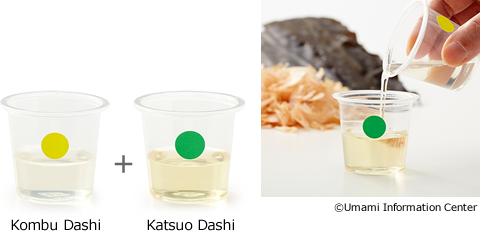

|
Umami Substances :
|
Glutamate
|
|
Inosinate
|
For the second tasting, we use two types of bouillon: bouillon made of only vegetables which Imparts glutamate and bouillon made of only chicken which mainly imparts inosinate.
How to Taste
- Sip half of the vegetable bouillon and allow the taste to spread over your tongue to taste the umami.
- Sip half of the chicken bouillon and allow it to spread over your tongue to taste the umami.
- Sip a small quantity of water and rinse your mouth.
- Pour the rest of the vegetable bouillon into the cup of chicken the bouillon.
- Sip the mixture carefully.
Drinking mixed bouillon 5., you may feel a stronger umami taste than 1.&2., due to the two types of bouillon: vegetable bouillon and chicken bouillon. This is the synergistic effect of umami. It produces
umami 7~8 times higher than those found in single bouillon. Western stocks such as French bouillon and Chinese tang stocks combine vegetables with fish or meat products, thereby allowing glutamate and
nucleotides to come into contact.
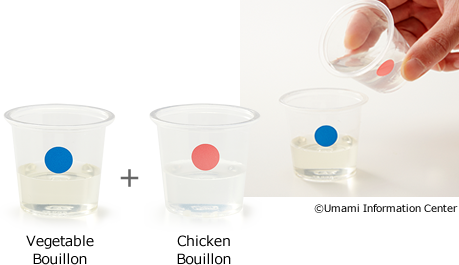

Vegetable bouillon contains amino acid glutamate which imparts umami. To compare the strength of umami, we prepare a version with added glutamate. To prepare vegetable bouillon, please refer to “ How to Experience Umami”.

|
Umami Substances :
|
Glutamate
|
How to Prepare
Ingredients:
- ・800g (28 oz.) of vegetable bouillon
(Using 1 l of water will afford 800 ml of vegetable bouillon.)
- ・2.4g of salt (0.3% weight of bouillon mentioned above)
- ・0.4g of Monosodium Glutamate (MSG) (0.1% of 400g)
Preparation:
- 1. Add salt to the vegetable bouillon.
- 2. Divide 1. into two containers.
- 3. Add MSG into one of 2..
- 4. Pour the version without additional MSG into the tasting cup with the blue sticker.
- 5. Pour the other bouillon with additional MSG into the tasting cup with the red sticker.
How to Taste
- Sip the bouillon in the cup with the blue sticker, allowing it to spread over your tongue to taste the umami.
- Sip the bouillon in the cup with the red sticker, allowing it to spread over your tongue to taste the umami.
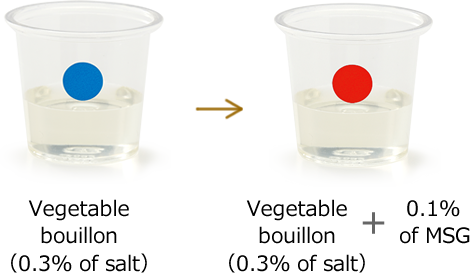
What do you taste?
Drinking1., you may feel the taste of vegetables such as carrot and celery separately while for 2., you may feel not only a stronger umami than 2. but also a better balanced taste thanks to the
additional umami. This is one of the effects of umami.

Let’s compare the taste of vegetable bouillon and vegetable bouillon with added chicken. For the preparation of vegetable bouillon, please refer “ How to Experience Umami ”. To
prepare the other bouillon, vegetable bouillon with added chicken is shown below.

|
Umami Substances :
|
Glutamate
|
|
Inosinate
|
How to Prepare
Ingredients:
- ・400g (14 oz.) of vegetable bouillon to which 0.3% salt of the total quantity has already been added
- ・100g (3.5 oz.) of minced chicken breast
Preparation:
- 1. Put vegetable bouillon and minced chicken breast in a pan and flake the meat.
- 2. Heat up by medium heat until the meat cooked.
- 3. Place cotton cloth or kitchen paper on a strainer and strain bouillon with scum.
- 4. Pour vegetable bouillon without chicken breast into the tasting cup with blue sticker.
- 5. Pour another bouillon with chicken breast into the tasting cup with pink sticker.
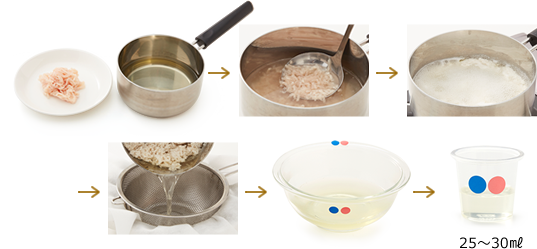
How to Taste
- Sip the bouillon in the cup with the blue sticker, allowing it to spread over your tongue to taste the umami.
- Sip the bouillon in the cup with the pink sticker, allowing it to spread over your tongue to taste the umami.
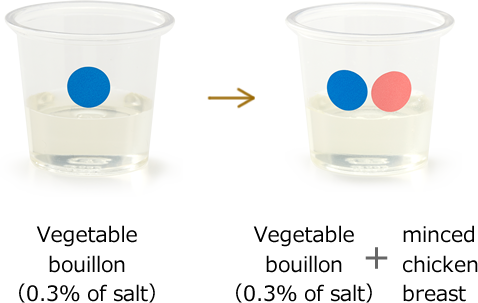
What do you taste?
Drinking 1., you may feel less saltiness in this cup that contains 0.3% salt of the total quantity. 2.in the cup with the pink sticker is the same recipe used in 1. but with added chicken. We don’t add
salt. Although the conventional bouillon recipe contains (about) 0.7 - 0.9% salt of the total weight, this recipe contains only 0.3% salt the same as in recipe 1.. However, we are satisfied with the
taste. Thus, if there is sufficient umami, the recipe can be tasty even with less salt. In this way, you can utilize umami for salt reduced recipes.
In 1., you may feel the taste of vegetables such as carrot and celery separately while for 2., you may feel not only a stronger umami than 1. but also the tastes are more rounded thanks to the
additional umami. This is one of the effects of umami.

